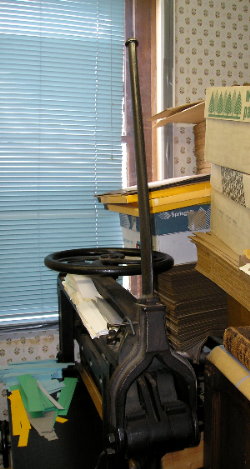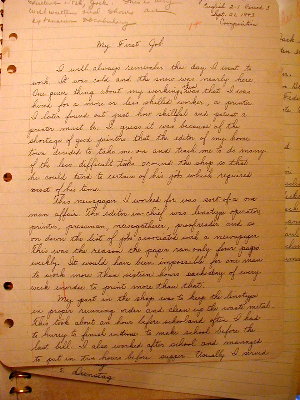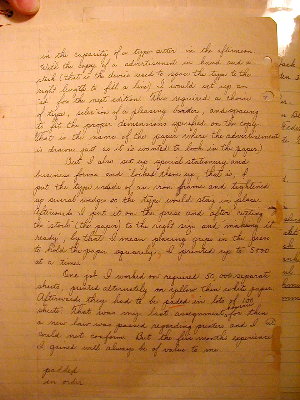"Jack"
June 04, 1929 - March 10, 1946
English
2-1 Period 3
Sept. 21, 1943
Composition

|
John Wychoff Swarthout
"Jack" June 04, 1929 - March 10, 1946
English
2-1 Period 3 |
 |
|
My First Job I will always remember the day I went to work. It was cold and the snow was nearly here. One queer thing about my working then was that I was hired for a more or less skilled worker, a printer. I later found out just how skillful and patient a printer must be. I guess it was because of the shortage of good printers that the editor of my home town decided to take me on and teach me to do many of the less difficult tasks around the shop so that he could end to certain of his jobs which required most of his time. This newspaper I worked for was sort-of-a one man affair. The editor-in-chief was linotype operator, printer, pressman, newsgatherer, proof-reader and so on down the list of jobs associated with a newspaper. This was the reason the paper ran only four pages weekly. It would have been impossible for one man to work more than sixteen hours each day of every week in order to print more than that. |
This is the Ovid, New York print shop today. It has been located in the same building for over a century. |
|
|
The linotype machine, the same one that was there in 1943! |
My part in the shop was to keep the linotype in proper running order and clean up the waste metal. This took about an hour before school and often I had to hurry to finish in time to make school before the last bell. I also worked after school and managed to put in two hours before supper. Usually I served in the capacity of a type-setter in the afternoon. With the copy of a advertisement in hand and a stick (that is the device used to space the type to the right length to fill a line) I would set up an 'ad' for the next edition. This required a choice of type, selection of a pleasing border, and spacing to fit the proper dimensions specified on the copy. (That is the name of the paper where the advertisement is drawn just as it is wanted to look in the paper.) | |
|
But I also set up special stationary and business forms and 'locked them up,' that is, I put the type inside of an iron frame and tightened up several wedges so the type would stay in place. Afterwards I put it on the press and after cutting the 'stock' (the paper) to the right size and 'making it ready,' by that I mean placing grips in the press to hold the paper squarely I printed up to 5000 at a time. One
job I worked on required 50,000 separate sheets, printed alternately on
yellow then white paper. Afterwards they had to be padded in lots of 100
sheets. That was my last assignment however for then a new law was passed
regarding printers and I could not conform. But the five month's experience
I gained will always be of value to me. |
 |
This is the cutter referred to. It was purchased in the late 1800's and is still being used today. |
 |
It is even more interesting to realize that Jack was the 3rd Great Grandson of the founder of the Ovid Bee, David Fairchild. David's son Corydon Fairchild ran the Ovid Bee for over 30 years. Jack had a box of treasures that his mother preserved, his Little Angel Box. Included was a piece of type. (Wayne, now you know where that missing 'd' went! or is it a p?) He received a 1+ from his teacher for the essay. Her comments were: I've done some work to find the law that went into effect in that time frame, but have yet to find it. I expect it was either a child labor law, or a trade apprentice regulation that prevented him from working at such a young age.
|
|
 |
 |
|